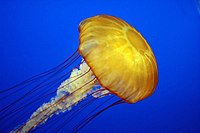
Photo from wikipedia
ABSTRACT The visual systems and diel activity patterns of butterflies and moths have been studied for decades, yet understanding the underlying mechanisms that are associated with the evolution of these… Click to show full abstract
ABSTRACT The visual systems and diel activity patterns of butterflies and moths have been studied for decades, yet understanding the underlying mechanisms that are associated with the evolution of these remains a major challenge. The order Lepidoptera is principally composed of nocturnal lineages with extreme morphological and behavioural adaptations to this lifestyle. Although most butterflies are diurnal, some clades are predominantly nocturnal, for instance, the Hedylidae. Skippers are another family that comprises multiple crepuscular and/or nocturnal lineages. Interestingly, many such lineages have red-eye pigmentation, and this morphological feature has been hypothesised to be an adaptation to the night-time lifestyle. Here, we review the occurrence and frequency of red-eye pigmentation as well as diel activity patterns in Hesperiidae. We place these data within a phylogenomic framework and provide hypotheses and predictions relative to the evolution of red-eye pigmentation in skippers with respect to diel activity. We suggest that several types of red-eye pigmentation exist in skippers, with possible structural red-eye pigmentation in some lineages of diurnal skippers. The colouration of eyes in Hesperiidae, the evolutionary mechanisms that drive these traits and the physiological underlying processes require further attention and could bring new insights into our understanding of butterfly vision systems.
Journal Title: Journal of Natural History
Year Published: 2019
Link to full text (if available)
Share on Social Media: Sign Up to like & get
recommendations!